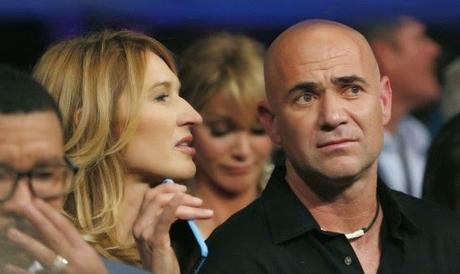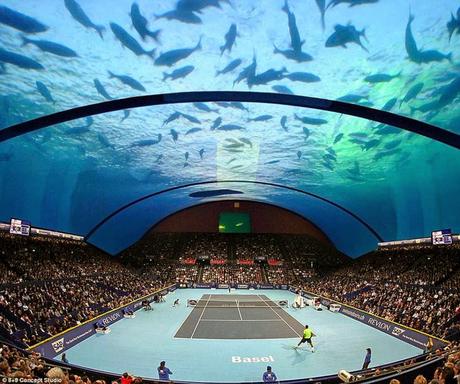 Burj Al Arab is a luxury hotel located in Dubai, United
Arab Emirates. It has been called "The world's only 7 star Hotel" and
is the third tallest hotel in the world; however, 39% of its total height is
made up of non-occupiable space. It stands
on an artificial island 280 m (920 ft) from Jumeirah beach and is connected to
the mainland by a private curving bridge. The shape of the structure is
designed to mimic the sail of a ship. It has a helipad near the roof at a
height of 210 m (689 ft) above ground.
A good match can bring the viewers to the tip of
their seats – tense someone could
bite-off their nails – there can also be
matches with none watching – for this one was at a
dizzying height – a green roof, infact
the helipad of the luxury hotel – the competitors were World famous –
Andre Agassi and Roger Federer, but the result was no important.
Burj Al Arab is a luxury hotel located in Dubai, United
Arab Emirates. It has been called "The world's only 7 star Hotel" and
is the third tallest hotel in the world; however, 39% of its total height is
made up of non-occupiable space. It stands
on an artificial island 280 m (920 ft) from Jumeirah beach and is connected to
the mainland by a private curving bridge. The shape of the structure is
designed to mimic the sail of a ship. It has a helipad near the roof at a
height of 210 m (689 ft) above ground.
A good match can bring the viewers to the tip of
their seats – tense someone could
bite-off their nails – there can also be
matches with none watching – for this one was at a
dizzying height – a green roof, infact
the helipad of the luxury hotel – the competitors were World famous –
Andre Agassi and Roger Federer, but the result was no important.
 On February 22, 2005, the Burj al Arab
hosted Andre Agassi and Roger Federer to play a match on their helipad tennis
court before heading to the US$1 million Dubai Duty Free Men’s Open,
which was the first round of the two-week Dubai Tennis Championships. The
hotel’s helipad is situated 211 meters high and covers a surface area of 415 sq
m. Although the court was plenty big enough to
play at their fullest, it must have been scary to run too fast or hit too hard
for fear of getting close to the edge. There was a
net around the pad, but still,... worrisome
They
were not alone in the sense, that sometime later, Tiger
Woods played golf on top of Burj Al Arab hotel in Dubai. If that was funny idea, there is more as
MailOnline reports of plans for an
underwater tennis court off the coast of Dubai.
It is stated that Polish
architect Krzysztof Kotala, 30 is looking for investors to turn his dream of an
underwater court into a reality.
The architect has served up plans for an
underwater tennis court complete with a massive curved roof that he envisages
would keep the water out and let players see fish swimming above. He wants to build the glass clad-court in
Dubai, which has a track record of pushing the boundaries of architecture and
engineering, by building the Burj Tower - the tallest skyscraper in the world -
and the man-made Palm Islands, for example. However, engineers warn that such a design may
be prohibitively expensive and incredibly difficult to execute.
Polish architect
Krzysztof Kotala, 30, who has a Master of Science in Architecture from Krakow
Polytechnic, is looking for investors to turn his dream into reality. The owner of 8 + 8 Concept Studio in Warsaw,
said: ‘This will be something original. It should be somewhere where there is
the tradition of tennis. Dubai is perfect for this idea.’ Mr Kotala said he believes the idea has
strong commercial potential and would combine the best of technology, ecology
and sport.
On February 22, 2005, the Burj al Arab
hosted Andre Agassi and Roger Federer to play a match on their helipad tennis
court before heading to the US$1 million Dubai Duty Free Men’s Open,
which was the first round of the two-week Dubai Tennis Championships. The
hotel’s helipad is situated 211 meters high and covers a surface area of 415 sq
m. Although the court was plenty big enough to
play at their fullest, it must have been scary to run too fast or hit too hard
for fear of getting close to the edge. There was a
net around the pad, but still,... worrisome
They
were not alone in the sense, that sometime later, Tiger
Woods played golf on top of Burj Al Arab hotel in Dubai. If that was funny idea, there is more as
MailOnline reports of plans for an
underwater tennis court off the coast of Dubai.
It is stated that Polish
architect Krzysztof Kotala, 30 is looking for investors to turn his dream of an
underwater court into a reality.
The architect has served up plans for an
underwater tennis court complete with a massive curved roof that he envisages
would keep the water out and let players see fish swimming above. He wants to build the glass clad-court in
Dubai, which has a track record of pushing the boundaries of architecture and
engineering, by building the Burj Tower - the tallest skyscraper in the world -
and the man-made Palm Islands, for example. However, engineers warn that such a design may
be prohibitively expensive and incredibly difficult to execute.
Polish architect
Krzysztof Kotala, 30, who has a Master of Science in Architecture from Krakow
Polytechnic, is looking for investors to turn his dream into reality. The owner of 8 + 8 Concept Studio in Warsaw,
said: ‘This will be something original. It should be somewhere where there is
the tradition of tennis. Dubai is perfect for this idea.’ Mr Kotala said he believes the idea has
strong commercial potential and would combine the best of technology, ecology
and sport.
 While
the proposer and spectators may be
enthusiastic, engineers thinks the project is unlikely to come off because of
technical difficulties and cost. Sarah Fray, director of engineering and
technical services at the Institution of Structural Engineers in London, told
MailOnline that one of the biggest challenges would be to create the large span
of glass to cover the court. She said
this would have to be at least 108 ft (33 metres) wide to accommodate the court
and spectators. Currently, flat panels of glass can be manufactured in single
pieces around 32 ft (10 metres) long - such as panels used in Apple’s store in
Turkey - but new machinery would have to be invented to make larger panes of
curved glass, the type of which would be needed for the design.
Adding technical angle, Ms Fray said: ‘I don’t
know if you could play tennis in it - there’s light refracting above and I
don’t know how you’d control it. I can’t imagine players not finding the fish
distracting either.' A concept of the building from the player's point of view
is shown. ‘The more joints there are,
the more likely it would leak,’ Ms Fray said. ‘The design would also need to be
thought out in terms of how it would react to an impact. ‘Any boat would have to be kept well clear
and a dropped anchor would destroy it,’ she warned, adding that the design
would have to withstand earthquakes and tsunamis too. ‘The technological challenges are big, but
the human challenges are bigger,’ she said, explaining that there would have to
be a way for the structure to be connected to the surface and easily evacuate
people in the event of an emergency.
One
cannot entirely dismiss it as a crazy idea – as there are some crazy people
around – and perhaps tennis underwater too might become a possibility - may not be the game for the ordinary game
lover – but for rich aristocrats seeing funny things happening, even as a
technical expert quipped that 'Water in
general and seawater in particular is not colourless,' meaning that the outside
may look murky.
With regards – S.
Sampathkumar
While
the proposer and spectators may be
enthusiastic, engineers thinks the project is unlikely to come off because of
technical difficulties and cost. Sarah Fray, director of engineering and
technical services at the Institution of Structural Engineers in London, told
MailOnline that one of the biggest challenges would be to create the large span
of glass to cover the court. She said
this would have to be at least 108 ft (33 metres) wide to accommodate the court
and spectators. Currently, flat panels of glass can be manufactured in single
pieces around 32 ft (10 metres) long - such as panels used in Apple’s store in
Turkey - but new machinery would have to be invented to make larger panes of
curved glass, the type of which would be needed for the design.
Adding technical angle, Ms Fray said: ‘I don’t
know if you could play tennis in it - there’s light refracting above and I
don’t know how you’d control it. I can’t imagine players not finding the fish
distracting either.' A concept of the building from the player's point of view
is shown. ‘The more joints there are,
the more likely it would leak,’ Ms Fray said. ‘The design would also need to be
thought out in terms of how it would react to an impact. ‘Any boat would have to be kept well clear
and a dropped anchor would destroy it,’ she warned, adding that the design
would have to withstand earthquakes and tsunamis too. ‘The technological challenges are big, but
the human challenges are bigger,’ she said, explaining that there would have to
be a way for the structure to be connected to the surface and easily evacuate
people in the event of an emergency.
One
cannot entirely dismiss it as a crazy idea – as there are some crazy people
around – and perhaps tennis underwater too might become a possibility - may not be the game for the ordinary game
lover – but for rich aristocrats seeing funny things happening, even as a
technical expert quipped that 'Water in
general and seawater in particular is not colourless,' meaning that the outside
may look murky.
With regards – S.
Sampathkumar
6th May 2015.

